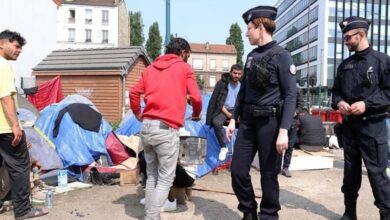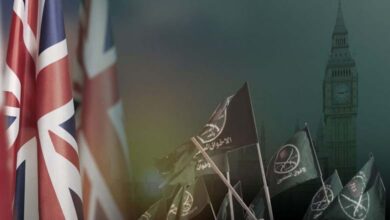The Lost Paths of Destiny: The Memory of Nazism Reveals a Secret from Decades Ago

Two sisters, “theoretically” separated by war and different paths, had no knowledge of each other’s existence for 60 years. However, fate proved stronger than the camps.
-
World War II Threatens the UK with 170 ‘Dormant’ Bombs
-
World War II Deception: A Japanese Military Ship in the California Desert
Sola, the American, and Hélène, the German, were unaware of each other’s existence until they discovered, 60 years later, that they were half-sisters through their father, a survivor of Nazi death camps who had immigrated to the United States.
Floriane Azoulay, director of the “Bad Arolsen” archives, recounts: “Sola Miller contacted us because she was looking for information about her father,” who was born in the Austro-Hungarian Empire and survived the Auschwitz-Birkenau (in Poland) and Buchenwald (in Germany) concentration camps.
A file kept for decades by the institution, along with a meticulous investigation to trace clues, revealed her father’s story and helped locate Hélène’s half-sister. Floriane adds, “Thanks to us, the two women were able to meet.”
-
Ukrainian Incursion in the Largest Attack on Russia Since World War II: What Is Happening on the Border?
-
World War II: The Strangest and Most Failed Weapons
80 Years After the End of World War II, Research Continues
Despite the 80 years since the end of World War II, people around the world continue to uncover the fate of their relatives who were detained in Nazi death camps.
In this regard, Agence France-Presse reports that there is only one place in the world that preserves the memory of millions of people “arrested and exterminated by the Nazis,” namely the archives of “Bad Arolsen,” a small town in central Germany.
Among the archives is a letter dating from 1951 mentioning the search for Mendel Muller’s wife, whom he met after the war in Germany, and the mother of his daughter Hélène, born in 1947.
-
“Military Service”: Europe’s Concerns Drive towards “Mandatory” Service
-
U-Boats: Germany’s Terrifying Weapon That Changed the Course of War
After obtaining his visa, he emigrated alone to the United States and started a new life there with an Austrian woman, who gave him a daughter, Sola, in 1960.
Four years after the research began, investigators from Bad Arolsen found Hélène.
The two women met last year. “Their physical similarities were striking, but each had a different view of their father, who had suffered from the trauma of incarceration. Their reunion helped them reconcile with their past,” explains Azoulay.
-
Updating Nuclear Shelters: Switzerland Prepares for a “World War Scenario”
-
Germany Prepares for a World War… “Protective Trenches” Linked to an Electronic “Fingerprint”
Digitization and Preservation of Archives
With 30 million documents about 17.5 million people stored in safes or boxes, the “Bad Arolsen” archives represent the largest collection on the victims of Nazism, 90% of which have now been digitized.
For the Dachau and Neungamme camps (near Hamburg), “we still have 2,000 envelopes containing watches, rings, wallets, and photos,” says the French director of the institution.
The original aim of these archives, called “International Tracing Services,” was to locate missing people, whether Jews, Roma, LGBTQ individuals, political dissidents, or Aryanized children, and reunite separated families.
-
The Victory Sign (V)… A Historic Journey that Began with the Hundred Years’ War
-
Wagner’s Founder Returns from the Grave: He Warned of Ukrainian Encroachment and Proposed a Solution
After about 80 years, the institution still exists, funded by the German Foreign Ministry.
Around 200 employees, with the help of around fifty volunteers worldwide, continue to search for descendants of victims whose personal belongings were preserved.
Despite the years that have passed and the disappearance of witnesses, the demand for these archives remains very high, with “20,000 requests per year” from all over the world, according to Azoulay.
-
World War Preparations? Europe’s Weapons Stuck on the Rails
-
Between Trump’s Hammer and Putin’s Anvil: Greenland’s Fate in the Hands of the Great Powers
Research on Abraham’s Family
Among these applicants is Abraham, a German born to Polish Jewish parents in a displaced persons camp in Bamberg, southern Germany.
Although he is approaching 80 years old, Abraham still hopes to learn the fate of his paternal family, whom he hasn’t seen since fleeing the Warsaw Ghetto. He believes that “the probability they died in the camps is high.”
He recalls that his father, a Holocaust survivor, “never spoke about the horrors he experienced, and we never asked him questions. We sensed it caused him pain.”
-
“The Deadly Lake”.. The Ghost of the Cold War Haunts a Russian Region
-
The Mystery of the American Military Plane… An Unfinished Secret Mission 63 Years Ago
At the Jewish refugee center where Abraham was born, almost no one had grandparents, as the elderly were the first to perish in the camps.
Abraham explains, “When I was ten, I realized that other children had grandparents, because I went to a German school, and my classmates would tell the teacher about the gifts they had received for Christmas.”
Abraham wishes to find “his surviving relatives” among his father’s five brothers and sisters. He then sought help from the curators of the Bad Arolsen archives, where he met Agence France-Presse.
-
“Zero Hour” Nuclear Crisis: Where Would the U.S. President Hide?
-
Elite Units That Paved the Way for Modern Special Forces
Bad Arolsen Archives: A Precious Work of Memory
The archives were created from Nazi administrative documents: arrest orders issued by the Gestapo (the Nazi secret police), relocation lists, camp records, and documents containing detailed information on all detainees.
Since the creation of the archives, the names of the victims have been categorized according to the phonetic alphabet to facilitate searches, as the same name could be written differently depending on the country of origin, not to mention the errors made during registration.
Thus, there are more than 800 ways to write “Ibrahimovitch,” explains Nicole Dominkos, a German responsible for managing the archives.
-
The Most Bombed Country in History Might Surprise You
-
Why Will Conspiracy Theories About the “CIA” Not Disappear?
The “Bad Arolsen” archives were later supplemented by Allied files when they received victims, as well as by correspondence between the Red Cross and Nazi administration.
Each victim’s file also contains all the correspondence written about them. For example, one can read a letter from 1948 from a woman survivor of Auschwitz-Birkenau, addressed to “International Tracing Services,” to find her daughter, whom she was separated from in the camp.
Volunteers in each country, like Manuela Goltsch in Poland, search the records and contact municipalities and cemetery administrations to locate descendants.
-
Pokrovsk… the “Gateway to Donetsk” that Russia is striving to seize
-
Krystyna Skarbek: The Spy Who Conquered Horror, Earned Churchill’s Admiration, and Was Ultimately Killed by a Lover
Goltsch recently returned a pair of earrings and a watch to the 93-year-old daughter of a Polish woman arrested in 1944 after the Warsaw Uprising. She recalls: “She told me it was the happiest day of her life.”
German archivist Achim Werner (58) also recovered a wedding ring belonging to his grandfather, taken upon his arrival at the Dachau camp. When he received the ring, he said: “It was a shock.”












